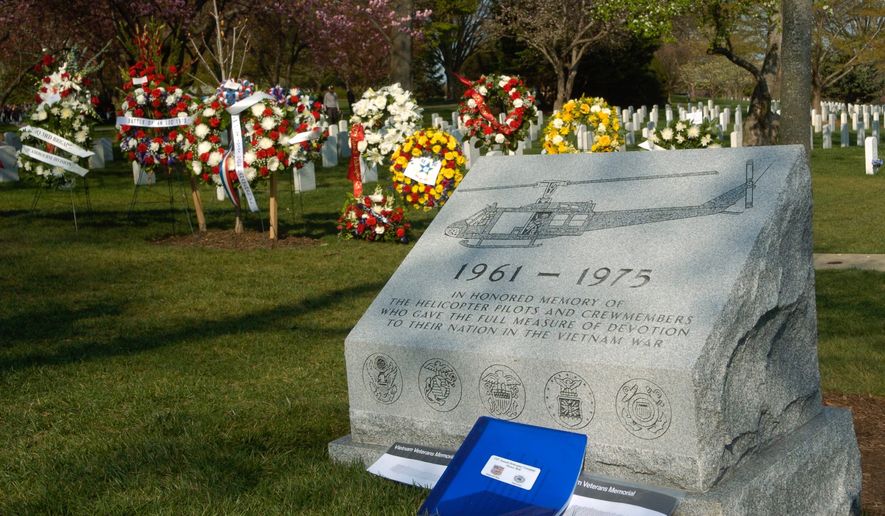Nearly 50 years ago, Col. Carl McNair was in South Vietnam’s Mekong Delta, a new Army aviator piloting the service’s iconic Bell UH-1 Huey helicopter. Decades and thousands of flight hours later, the now-retired Maj. Gen. McNair recalled his harrowing baptism under fire flying the unfriendly skies above Vietnam.
“We flew 13 hours that day,” he told the crowd of Vietnam veterans at Arlington National Cemetery, gathered on a sunny but cool Wednesday afternoon for the dedication of the Vietnam Helicopter Pilot and Crewmember Monument. “We all flew to the sounds of the guns,” he said.
On another helicopter mission in the Vietnam War, a crew member aboard another Army Huey would have his life cut short. David Kink was one of the nearly 5,000 American helicopter aviators who lost their lives during the course of the conflict. To the family of Kink and all those pilots and crew members who lost loved ones in Vietnam, the familiar whomp-whomp of the Huey’s rotor blades in flight is a reminder of what they had lost.
“When I was growing up, the sound of a helicopter was the sound of sadness,” David Kink’s sister, Julie, said during the dedication ceremony, held in the cemetery’s outdoor auditorium near Section 35 and just a few feet from the iconic Tomb of the Unknown Soldier.
But in her grief, Ms. Kink said, she found solace in the fact that the same sound that brought so much pain for her family was the sound of salvation for the soldiers and Marines who depended on the fleet of Hueys and CH-47 Chinooks as their lifelines in the jungles and rice paddies of Southeast Asia, delivering supplies, providing cover and evacuating the wounded.
“To the men fighting the war, it was the sound of hope … to carry them out of hell,” she said.
To the veterans of the air war in Vietnam, Wednesday’s event was a long time coming. Over 12,000 helicopters participated in combat operations throughout the war. Given the Vietnamese topography and the nature of the fighting, helicopters assumed an outsized role in a war they had never seen before.
“Vietnam will always be known as the helicopter war,” Gen. McNair said.
The National Mall’s Vietnam Veterans Memorial, with its iconic black granite slabs bearing the names of the 58,000 Americans killed, received international acclaim for its somber but emotional take on one of the most divisive conflicts in U.S. history. But erecting the 2.5-by-2.5-foot granite block engraved with an image of an Army Huey commemorating Vietnam’s air warriors proved an unexpectedly difficult fight.
Army officials declined the request by the Vietnam Helicopter Pilots Association in 2014, saying Arlington Cemetery’s hallowed grounds lacked the space to support another war memorial. Undeterred, association officials reached out to Congress and eventually garnered enough support for a law authorizing the memorial.
“It’s hard to get a memorial here, and it should be,” Rep. Mark E. Amodei, Nevada Republican and a key sponsor of the legislation, said during the ceremony. He said the tenacity of the association and other Vietnam veterans groups was a testament to the groups’ dedication to honor their fallen comrades in arms.
“Helicopter pilots and crew members risked their lives again and again to lead offenses, transport troops and save lives. A monument in Greater Washington, D.C., to their bravery is overdue,” Rep. Matt Cartwright, Pennsylvania Democrat and another co-sponsor of the legislation, said in a statement.
The memorial, Ms. Kink said, was not built by the government but “by the men who flew alongside our loved ones” in Vietnam. “They will never be forgotten,” she said. To those who survived the war, Vietnam will always be a part of them.”
“I think about it every single day. Every single day,” said Jim Holden, who flew Hueys in Vietnam in 1967 and 1968. He recalled telling his grandson’s Boy Scout troop about his experiences during the war.
“We survived,” said Hugh Adams, who flew and fought in Vietnam in 1968 and 1969, as several Hueys flew in formation above the cemetery to mark the memorial’s dedication. It was the duty of those who made it out of the war to remember the ones who gave their lives there, Mr. Adams said.
“Anyone who experienced a single taste of war … you all likely have the scars and the medals to show” for the sacrifices made in Vietnam, Gen. McNair said. “I salute you all for your service. We are soldiers for life.”
• Carlo Muñoz can be reached at cmunoz@washingtontimes.com.




Please read our comment policy before commenting.